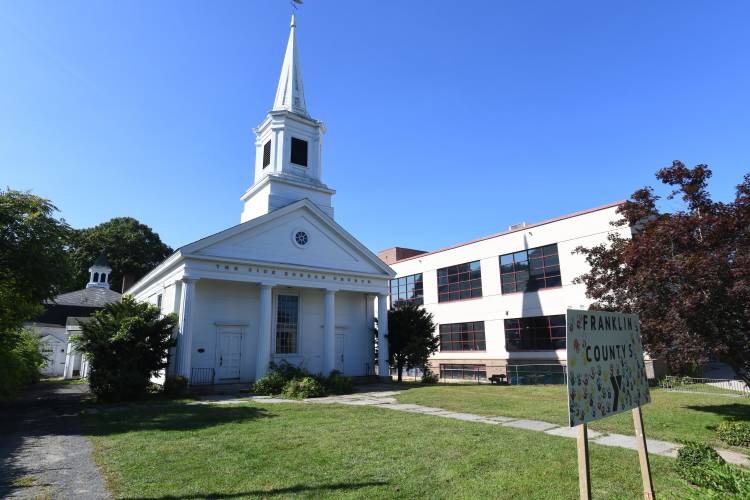Asbestos removal marks latest step in relocation of former Zion Korean Church to Barre

The former Zion Korean Church next to Franklin County’s YMCA on Main Street in Greenfield. STAFF FILE PHOTO/PAUL FRANZ
|
Published: 02-25-2025 2:08 PM
Modified: 03-27-2025 3:28 PM |
GREENFIELD — Hazardous materials crews have cleared asbestos from the former Zion Korean Church in accordance with an agreement between a farm owner in Barre and Franklin County’s YMCA to move the historic building in the months ahead, saving it from demolition.
The Historical Commission announced that the contract had been signed at its meeting last Thursday — nearly two months after the commission designated the 463 Main St. church site a “preferably preserved significant building” on Jan. 2, kicking off a six-month demolition delay. The designation came as Franklin County’s YMCA announced its plans to either relocate or demolish the church to expand its playground and create a third preschool classroom.
Franklin County’s YMCA CEO Grady Vigneau, in an interview Monday, said contractors will soon begin work disconnecting the church from utilities before Philip Stevens, owner of Carter & Stevens Farm LLC in Barre, is expected to begin dismantling the building in late March or early April. Vigneau explained that as a condition of the contract, the church must be rebuilt in accordance with its original design.
“Phil [Stevens] is highly, highly regarded as someone who really respects history and does everything he can to make sure that historical buildings are preserved,” Vigneau said. “The fact that it’s going back to its original home is just icing on the cake.”
The church building was built as the Coldbrook Springs Baptist Church in Barre in the 1840s and sits in the East Main/High Street Historic District on the National Register of Historic Places. The Greenfield Christian Scientist congregation bought the Greek revival-style church and moved it to Greenfield in 1936.
Although a June 9, 1953, Greenfield Recorder article stated that the church hosted abolitionist speakers such as William Lloyd Garrison and was moved to Greenfield from Barre during the construction of the Quabbin Reservoir, research conducted by Barre Historical Commission Chair Lucy Allen could not confirm the church’s ties to the abolitionist movement. She also said the church was moved from Barre as part of the Ware River Diversion Project.
Stevens’ family, which has already moved 10 different buildings — six of which are historic — will undertake the meticulous process of dismantling, moving and rebuilding the church, Vigneau said. Vigneau added that the YMCA will contribute some of the donations it initially received to demolish the church to assist Stevens with dismantling and moving the building.
“Our entire organization, from our board, to myself as CEO, to our staff, is just really pleased and excited that the church is going to be safe — the church is going to be reconstructed in its original town. And we’re all so excited, and that’s from a historical perspective and from a community perspective,” Vigneau said. “This has been a long process with the city, but I am very, very pleased and very proud of the way the city and the community were able to work together and come to an optimal solution to a very difficult situation.”
Article continues after...
Yesterday's Most Read Articles
In previous discussions on the church, Historical Commission member Jeremy Ebersole also expressed excitement for the church’s return to Barre, pointing out how rare it is to see a historical building move from one municipality to another and then return to its hometown. Ebersole referred to the move as a “minor miracle.”
“It’s very rare to find situations like this. Small-town historical societies are not always known for their vast amounts of resources,” Ebersole said. “I was not holding out for that solution, but it’s very rare for something like this to happen in the way that it has.”
Anthony Cammalleri can be reached at acammalleri@recorder.com or 413-930-4429.






 Ahead of renovations, Memorial Hall Association invites residents to take a seat from historic theater
Ahead of renovations, Memorial Hall Association invites residents to take a seat from historic theater Customer demand drives expansion of Flis Market’s pizza offerings
Customer demand drives expansion of Flis Market’s pizza offerings Protesters to state officials: Change clean energy siting rules in new Climate Action Plan
Protesters to state officials: Change clean energy siting rules in new Climate Action Plan  ‘We’ve lost a good one’: Donald R. Dwight remembered as passionate advocate for local journalism
‘We’ve lost a good one’: Donald R. Dwight remembered as passionate advocate for local journalism
